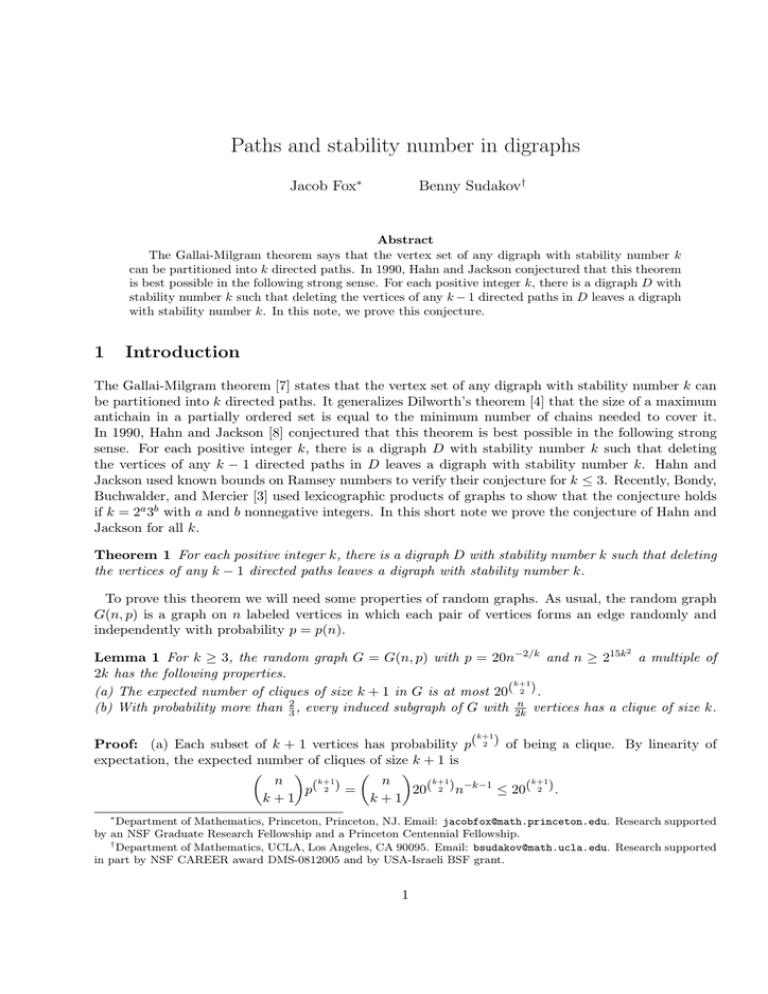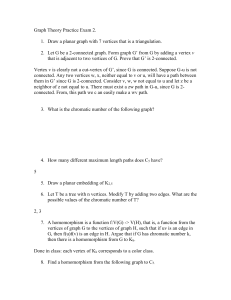Paths and stability number in digraphs 1 Introduction Jacob Fox
advertisement

Paths and stability number in digraphs Jacob Fox∗ Benny Sudakov† Abstract The Gallai-Milgram theorem says that the vertex set of any digraph with stability number k can be partitioned into k directed paths. In 1990, Hahn and Jackson conjectured that this theorem is best possible in the following strong sense. For each positive integer k, there is a digraph D with stability number k such that deleting the vertices of any k − 1 directed paths in D leaves a digraph with stability number k. In this note, we prove this conjecture. 1 Introduction The Gallai-Milgram theorem [7] states that the vertex set of any digraph with stability number k can be partitioned into k directed paths. It generalizes Dilworth’s theorem [4] that the size of a maximum antichain in a partially ordered set is equal to the minimum number of chains needed to cover it. In 1990, Hahn and Jackson [8] conjectured that this theorem is best possible in the following strong sense. For each positive integer k, there is a digraph D with stability number k such that deleting the vertices of any k − 1 directed paths in D leaves a digraph with stability number k. Hahn and Jackson used known bounds on Ramsey numbers to verify their conjecture for k ≤ 3. Recently, Bondy, Buchwalder, and Mercier [3] used lexicographic products of graphs to show that the conjecture holds if k = 2a 3b with a and b nonnegative integers. In this short note we prove the conjecture of Hahn and Jackson for all k. Theorem 1 For each positive integer k, there is a digraph D with stability number k such that deleting the vertices of any k − 1 directed paths leaves a digraph with stability number k. To prove this theorem we will need some properties of random graphs. As usual, the random graph G(n, p) is a graph on n labeled vertices in which each pair of vertices forms an edge randomly and independently with probability p = p(n). 2 Lemma 1 For k ≥ 3, the random graph G = G(n, p) with p = 20n−2/k and n ≥ 215k a multiple of 2k has the following properties. k+1 (a) The expected number of cliques of size k + 1 in G is at most 20( 2 ) . n vertices has a clique of size k. (b) With probability more than 23 , every induced subgraph of G with 2k k+1 Proof: (a) Each subset of k + 1 vertices has probability p( 2 ) of being a clique. By linearity of expectation, the expected number of cliques of size k + 1 is µ ¶ µ ¶ k+1 k+1 k+1 n n ( ) 2 p = 20( 2 ) n−k−1 ≤ 20( 2 ) . k+1 k+1 ∗ Department of Mathematics, Princeton, Princeton, NJ. Email: jacobfox@math.princeton.edu. Research supported by an NSF Graduate Research Fellowship and a Princeton Centennial Fellowship. † Department of Mathematics, UCLA, Los Angeles, CA 90095. Email: bsudakov@math.ucla.edu. Research supported in part by NSF CAREER award DMS-0812005 and by USA-Israeli BSF grant. 1 n (b) Let U be a set of 2k vertices of G. We first give an upper bound on the probability that U has no clique of size k. For each subset S ⊂ U with |S| = k, Let BS be the event that S forms a clique, and XS be the indicator random variable for BS . Since k ≥ 3, by linearity of expectation, the expected number µ of cliques in U of size k is " # µ ¶ n X k k nk XS = 2k p(2) ≥ µ=E 20(2) n1−k ≥ 2n. k k 2(2k) k! S Let ∆ = P ∆ = Pr[BS ∩ BT ], where the sum is over all ordered pairs S, T with |S ∩ T | ≥ 2. We have k−1 X X Pr[BS ∩ BT ] = i=2 |S∩T |=i ≤ k−1 X i=2 k−1 X X k i p2(2)−(2) = i=2 |S∩T |=i i n2k−i pk(k−1)−(2) ≤ 20k 2 k−1 X ¶µ ¶ k−1 µ ¶µ X n n − i n − k 2(k)−( i ) p 2 2 i k−i k−i i=2 2 n2−i+i(i−1)/k ≤ k20k n2/k . i=2 Here we used the fact that i(i − 1)/k − i for 2 ≤ i ≤ k − 1 clearly achieves its maximum when i = 2 or i = k − 1. 2 Using that k ≥ 3 and n ≥ 215k , it is easy to check that ∆ ≤ n. Hence, by Janson’s inequality (see, e.g., 8.11 of [2]) we can bound the probability that U does not contain a clique of size k by £ Theorem ¤ n vertices of Pr ∧S B̄S ≤ e−µ+∆/2 ≤ e−n . By the union bound, the probability is a set of 2k ¡ n ¢ −nthat nthere −n 2 G(n, p) which does not contain a clique of size k is at most n e ≤ 2 e < 1/3. 2k The proof of Theorem 1 combines the idea of Hahn and Jackson of partitioning a graph into maximum stable sets and orienting the graph accordingly with Lemma 1 on properties of random graphs. 2 Proof of Theorem 1. Let k ≥ 3 and n ≥ 215k . By Markov’s inequality and Lemma 1(a), the k+1 probability that G(n, p) with p = 20n−2/k has at most 2 · 20( 2 ) cliques of size k + 1 is at least 1/2. n Also, by Lemma 1(b), we have that with probability at least 2/3 every set of 2k vertices of this random graph contains a clique of size k. Hence, with positive probability (at least 1/6) the random graph G(n, p) has both properties. This implies that there is a graph G on n vertices which contains at most k+1 n 2 · 20( 2 ) cliques of size k + 1 and every set of 2k vertices of G contains a clique of size k. Delete one k+1 vertex from each clique of size k + 1 in G. The resulting graph G0 has at least n − 2 · 20( 2 ) ≥ 3n/4 vertices and no cliques of size k + 1. Next pull out vertex disjoint cliques of size k from G0 until the remaining subgraph has no clique of size k, and let V1 , . . . , Vt be the vertex sets of these disjoint n contains a clique of size k, then cliques of size k. Since every induced subgraph of G of size at least 2k 3n n n |V1 ∪ . . . ∪ Vt | ≥ 4 − 2k ≥ 2 . Define the digraph D on the vertex set V1 ∪ . . . ∪ Vt as follows. The edges of D are the nonedges of G. In particular, all sets Vi are stable sets in D. Moreover, all edges of D between Vi and Vj with i < j are oriented from Vi to Vj . By construction, the stability number n of D is equal to the clique number of G0 , namely k. Also any set of 2k vertices of D contains a stable set of size k. Note that every directed path in D has at most one vertex in each Vi . Hence, deleting n any k − 1 directed paths in D leaves at least |D|/k ≥ 2k remaining vertices. These remaining vertices contain a stable set of size k, completing the proof. 2 Remark. Note that in order to prove Theorem 1, we only needed to find a graph G on n vertices with n no clique of size k + 1 such that every set of 2k vertices of G contains a clique of size k. The existence of such graphs were first proved by Erdős and Rogers [6], who more generally asked to estimate the minimum t for which there is a graph G on n vertices with no clique of size s such that every set of 2 t vertices of G contains a clique of size r. Since then a lot of work has been done on this question, see, e.g., [9, 1, 10, 5]. Although most result for this problem used probabilistic arguments, Alon and Krivelevich [1] give an explicit construction of an n-vertex graph G with no clique of size k + 1, such that every subset of G of size n1−²k contains a k-clique. Since we only need a much weaker result to prove the conjecture of Hahn and Jackson, we decided to include its very short and simple proof to keep this note self-contained. Acknowledgments. We would like to thank Adrian Bondy for stimulating discussions and generously sharing his presentation slides. We also are grateful to Noga Alon for drawing our attention to the paper [1]. Finally, we want to thank the referee for helpful comments. References [1] N. Alon and M. Krivelevich, Constructive bounds for a Ramsey-type problem, Graphs Combin. 13 (1997), 217–225. [2] N. Alon and J. H. Spencer, The Probabilistic Method, 3rd ed., Wiley, 2008. [3] J. A. Bondy, X. Buchwalder, and F. Mercier, Lexicographic products and a conjecture of Hahn and Jackson, SIAM J. Discrete Math. 23 (2009), 882–887. [4] R. P. Dilworth, A decomposition theorem for partially ordered sets, Ann. of Math. 51 (1950), 161–166. [5] A. Dudek and V. Rödl, On Ks -free subgraphs in Ks+k -free graphs and vertex Folkman numbers, submitted. [6] P. Erdős and C. A. Rogers, The construction of certain graphs, Can. J. Math. 14 (1962), 702–707. [7] T. Gallai and A. N. Milgram, Verallgemeinerung eines graphentheoretischen Satzes von Rédei, Acta. Sci. Math. 21 (1960) 181–186. [8] G. Hahn and B. Jackson, A note concerning paths and independence number in digraphs, Discrete Math. 82 (1990), 327–329. [9] M. Krivelevich, Bounding Ramsey numbers through large deviation inequalities, Random Structures Algorithms 7 (1995), 145–155. [10] B. Sudakov, Large Kr -free subgraphs in K −s-free graphs and some other Ramsey-type problems, Random Structures Algorithms 26 (2005), 253–265. 3







